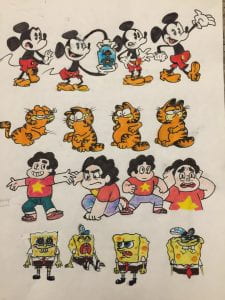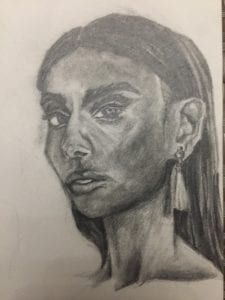Over the past few weeks, Ben and I have met with our mentor, and I’ve done some studies on facial expression and posture/body language. So far we’ve planned with our mentor to have a meeting around every month; there’s room for Ben and I to meet up independently with our mentor in order to further develop our In-Depth projects. Each session will most likely be around 1-2 hours depending on how our schedules line up and how much content needs to be covered within the session. A big portion of our communication will be through emails, as they’re easily accessible by both parties, even though it may take a while to get a response. Many of our questions and ideas will be brought to our sessions and will be answered in person. Depending on whether or not we have parental supervision, we will be meeting either at Simon’s animation studio or a local restaurant, library, etc. It’s best if we meet at Simon’s studio, as there will be more resources that we can access. In order to maintain our connection with each other, we’ll be communicating regularly with Simon through our email chain and updating him with new information on the progress of our projects.
During our first meeting with Simon, we discussed the 12 principles of animation (squash and stretch, anticipation, straight ahead action and pose to pose, etc.). Simon also showed us many different animation books for us to review on our own time, such as The Illusion of Life, Cartoon Animation, and The Animators Survival Kit. Simon recommended that I further study bone structure, muscle, and human anatomy, as they contribute very much to every animation.
After my previous post, I tried to draw and replicate different emotions from popular 2D cartoon characters, in order to study facial expression and posture. Through this study, I wanted to analyze how posture and expression impact pieces by setting an atmosphere, and how they create unique moods. With this study I tried to experiment with different styles and explore 2D drawings, as I don’t typically create 2D characters. I also wanted to find elements that make certain cartoon characters so iconic, I found that many cartoon characters were deceivingly simple. Recreating some of these characters took many tries, as every detail needed to be very sharp and precise in order to capture the true essence of each character; as each character is very simple, even the most minute details could fairly drastically alter the end product. After doing this study, I realized that a lot of expression in many cartoons is displayed through the eyes and mouth. Body language plays a very major role too, as they can heavily influence the mood that is actually displayed by a character. I was surprised to find that a majority of cartoons don’t use eyebrows to eventuate the emotions within characters.
Expression Study
Previous work on facial structure
As I’ve already studied facial structure, facial expression, and body language, I hope to study more settings and landscapes over the next few weeks, along with muscle structure. I plan on beginning to storyboard my first flip book animation and start to create my first animation. I haven’t progressed as much as I’ve planned to, so I’ll have to catch up over the break.
What three strategies could improve the quality of your mentoring interactions?
Strategies that could’ve improved the quality of our interactions could be having questions prepared ahead of time, so short amount of time together could be spent efficiently. Another thing that I could’ve done better would’ve been to have done more research, and come to the meeting prepared to participate in longer and deeper conversations. Finally, I should organize my time in a better way so I can have more work to show my mentor, as it would be easier for Simon to identify which areas I still need to improve on.
What is the action plan for implementing each of the three strategies?
In order to prepare ahead of time with questions, I could carry a notebook around and jot down notes related to my In-Depth project. That way, I could spend time to review my notes and address areas of confusion within my meetings with Simon. For the research side, it would be best if I organize a block of time specifically to research and study areas of interest for my project, and areas that Simon has recommended I apply myself to. For time management, I need to assign strict due dates for myself, and block out time every once in a while to continue to develop specific skills. The due date has to be a few days before the due date that I would’ve instinctively given myself, so I’m less likely to procrastinate to the point where I leave everything to the last day possible.
What went particularly well during your mentoring sessions?
During our meeting we covered a lot of content and information regarding the basics of animation. This session was really important, because Ben and I got a crash course in animation. We were taught information regarding the 12 principles of animation, we looked at different styles and mediums of animation, and Simon introduced us to some essential resources for animation. Within the hour or so that we met, there was a lot of important information for us to process, and I believe that all the information helped with my understanding of animation.
More to come – Brian


